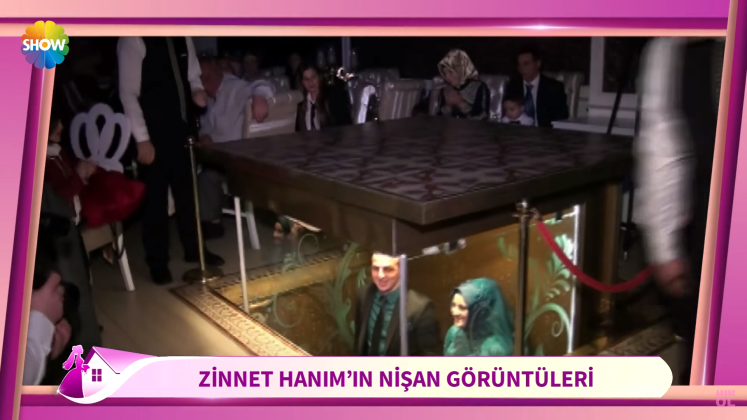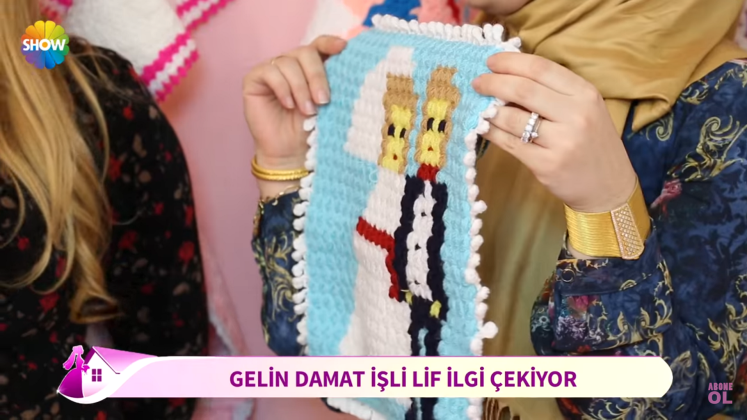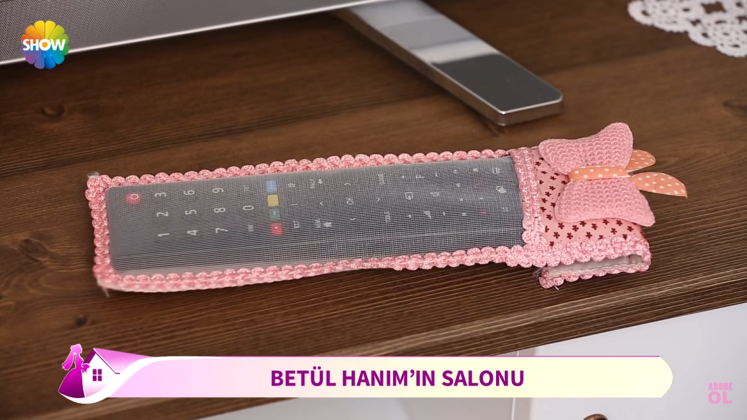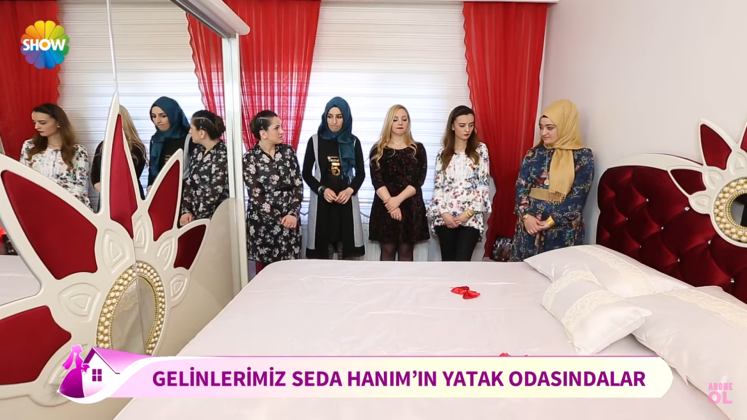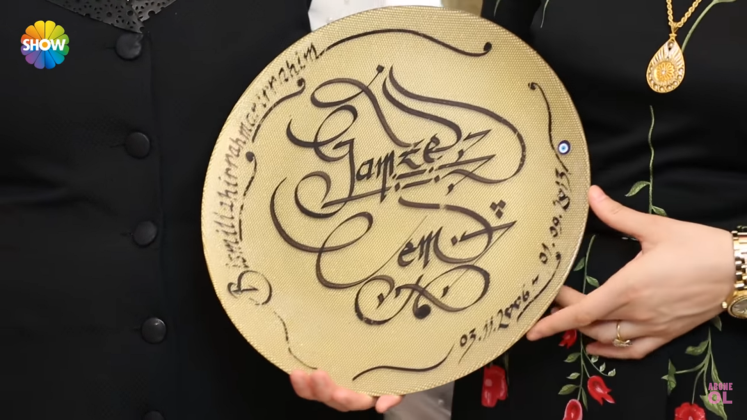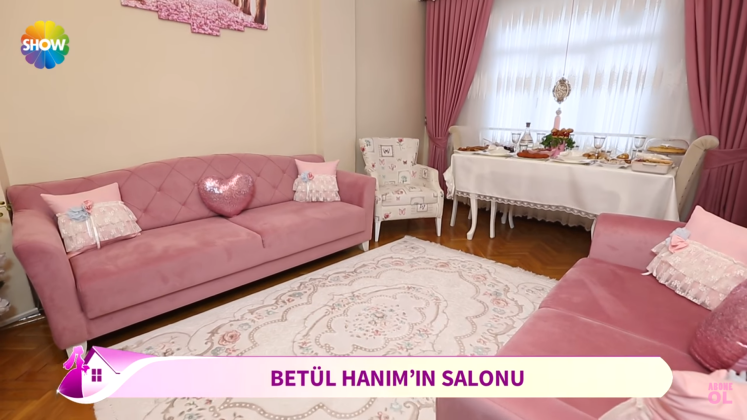The Bride's House or the Era of Hyper-Rituals
-I did not make any alterations; it came to me like this.
-That’s why I think you have also used red on creamy coffee colour sofas.
-Actually, I could have had them made in red, but they didn’t come in red. So, I chose pink...
-It’s nice, but I think it’s not standing out on a stone wallpaper; like the clock, for instance. It could have also looked nicer on a flatter surface.
-Well, I like the harmony of coffee and cream and pink, too, but it should be brown of this, more of a coffee; you know, just a little more...
-It's like a dark, hard coffee.
-Yeah, if it's a colder, darker coffee. And also, I am curious about the price.
-The wallpaper?
-First, let me know the wallpaper; then...
-The wallpaper costs 600 TL. Except for the workmanship, of course; just the wallpaper.
-The 3D wallpapers.
-That is why it is also a bit obtrusive to you.
-Yeah.
-Because it is 3D. If it were a normal wallpaper, it would not have been so obtrusive.
-Let's say they did not go well with each other, instead of, you know, saying obtrusive to our eyes.
-I think her sitting room was too confusing. It sometimes looked sportive, and sometimes classic.
Gelin Evi, Show TV, 2016.
Design is divided into two: the ones that deserve and the ones that do not deserve the seriousness of being a subject of design debates and criticisms. Certain design works are handled fairly, praised and polished from different angles. Certain others are not even worthy to be talked about. They are not even designs, so they are not worth discussing. They are quickly and thoroughly criticized to be discarded quickly with a cultural contempt at best. The design critic with raised eyebrows decides with infallible sharpness what is worth discussion. The Bride's House is a reality show on Turkish televisions, falling exactly on such an empty field – on the other side. In fact, it is a discard, an exception and an anomaly, that is, it does not have anything that is worthy of discussion. But if we can get rid of all our prejudices and postulations for a moment, it is hard to think of a better research topic than the Bride’s House to understand what is happening in the lives of a certain segment in Turkey1, how they live their transition rituals, and what is happening in their everyday lives – reaching up to its most intimate place.2
In this program, five brides visit each other's house –one another’s every day– and they sit back and talk in the living room. Everything that the hosting bride has experienced during and after the wedding, every activity she has done/has had done, every ritual she has performed, every object she has bought, every decision of spatial organization she has made is discussed exhaustively. In this bride-oriented investigation, which is more ruthless than a fearsome interrogation, everything is covered in every detail; from meeting with her husband, to how and where she received the marriage proposal, the promise of the bride’s side and the henna; from bachelor party –if any-, to the engagement, the wedding, the rent and features of the venue such as the ratio of the venue capacity to the invitees and participants3, the amount of jewellery and the photos taken4. At the end of the day, every bride comes to the kitchen and makes an evaluation of the day and holds the score she gives out of 10 up to the camera, by stitching it to a canvas.
Manners and Customs
"Weddings are ceremonies, with spectacular ceremonies at every stage, celebrated with a set of customs, beginning on Monday and ending on Friday, and lasting a few more days with dinner invitations."5
When we bring together the information about the marriage rituals in Anatolia in the research and writings of Sadi Yaver Ataman, Ahmet Rasim and Kudret Emiroglu, a spectacular network of customs and traditions emerge. Only a fraction of this network is as follows: Before the night of henna, a bride's bath is arranged for the bride-to-be; during the week of the wedding, the night of henna, where only the women participate, is arranged; the henna is applied to the right hand and right leg of the bride; the candles are circled over her head; and the bride-to-be is made cry. On the wedding day, in order to congratulate the bride, knick-knacks6 are sprinkled and bread is crumbled over the bride’s head, baklava is eaten at the wedding night (gerdek, or the bridal chamber), and the bride’s face is ornamented with a face writing...7 These and many different traditions define and shape the marriage culture on this geography.
In the Bride's House, we see a colossal hybridization of all these and more, constructed by the merging of almost everything in Turkey and around the world about marriage processes and customs. There is the Wedding March8 in this as well as the white wedding dress.9 A trans-traditional henna night, a European (American) bachelor party, the bride-to-be breaking a clay pot in front of the groom, to have the groom belly dance by means of a finger hooked through a belt loop of his trousers and moved horizontally; are not things that are unaccustomed, but rather accepted as indispensable. All of these come together and form a structure beyond rituals that we can call a hyper-ritual, for they are not just the sole accumulation of separate rituals. It does not stop there, either. Creative practices and experiences begin to emerge, such as entering the wedding hall on an knock-off phaeton10 by passing through the waiters carrying torches, on a boat11 sailing over the hall by the means of the rails attached to the ceiling, or with an elevator raising from underground (from a lower floor?).
-Ms. Esra, your dowry is beaded, lots of beads.
-Well, usually these are sequins.
-These are usually beads. Usually my mom made the beads. Sequined and beaded, lots of them...
-Which region do they come from?
-There is not a model that I can say belongs to a specific region, because we had only a crochet long beforehand.
-Well, I guess I saw a point lace there.
-Yes.
-If we look at it like this. The colours are so sweet again. That is, it's really trendy.
-More precisely, my mother-in-law herself has had this made, too. My mother-in-law loves pink very much, just like I do. That is, they say the bride is from the mother-in-law’s soil. It is definitely that.
-We have beads here, too.
Gelin Evi, Show TV, 2016.
Dowry
The dowry assessment is one of the most important parts of the show. In the guest room, all the pieces of the dowry are scattered around and even pinned to the curtains and examined one by one. Many different pieces, such as bathing gloves, laces, knitted socks, slippers, blankets, pillowcases and quilts are described to other brides as objects whose origin,12 functionality and producer13 are known. But, it is not clear from whom some of those came and why they are there in the first place. Sometimes the bride may be alienated to her dowry as much as not to know what a piece found in the dowry is and to say, “my mother-in-law has put it, too, in that thing”. In fact, this "thing",14 an important composition of the transmission of material culture through generations, is transformed into a collection of objects whose function has been forgotten suddenly or gradually, or that are simply supposed to be kept at home.
It is also possible to come across designs that are astonishingly successful in all of this visual spectacle and that we can almost be inspired for our own work. Bath gloves embroidered with the bride and the groom in a pixel-art-like style; sneaker knitted-socks bearing Converse logos; edge decorations with their proto-parametric designs; laces domesticating electronic products and other magnificent crochets; and shoes with different figures on each one of the pair, the kind that you would pay three-digit prices with the first one no less than three to buy from Camper; all parade in front of our eyes.
Furniture
We can talk about the fact that furniture in Turkey (as in many other sectors) has a peculiar and intermittent history. In furniture examination phase, this situation shows itself with all its reality. Sectors (and indirectly consumers) that cannot advance progressively and therefore cannot form their own design culture become open to all influences around by going adrift.
First of all, it is not wrong to say: In Bride’s House, furniture is not chosen based on the apartment. There is no such concept to settle into a certain volume. Instead, the desired furniture is chosen, and it is fitted into the room without considering the size and structure of the interior as a criterion. If a Hürrem type bedroom suite15 –a universe in which aesthetic concerns and criteria that you think, or you constrain yourself into do not exist or are seriously different– is to be preferred, the size or shape of the bedroom is not considered, and that suite is "somehow” fitted into that room. Brides who come to the bedroom in order to evaluate this part of the house have to act like two-dimensional cartoon characters in the space of 30 centimetres remaining between the bed and the wardrobe.
Every part of the house is filled with goods. No surface should remain empty. A lacework should hang down from every single shelf. There should be a cover on every single thing. Sofa suites, cabinets, sideboards, LED showcases, television units made from the thickest MDFs, a dining table –that will be able to accommodate crowded families when necessary– a must, curtains and more curtains, all kinds of trinkets, crystals and other doodads that are rich and satisfactory in every sense should be scattered all around the living room – no matter how small its volume is. But, of course, everything will have a cost. The woman titled “the bride”, who is considered to be unquestioningly responsible for tending to all these furniture and materials and ensuring the order and cleanliness of the house and rooms as well as arranging photo albums, preparing tables-meals-beds and looking after this giant froufrou machine called the house, is thus physically and mentally disconnected from the social life/public space and becomes the qualifier for the house: The Bride's House.
We can say that the Bride's House, like the "primordial soup",16 is a kind of human laboratory that contains dozens of different materials. The contents can be viewed from a sociological point of view as to how a fragment of the society works. Furthermore, any object, event, or concept that is shown/shown off, explained, or interpreted here, in fact, refers to different disciplines of design. Lace or knitting work can be stimulating in the context of product design and craftsmanship, invitations and albums in the context of graphic design, furniture and spatial items in the context of product design and interior architecture, and the henna, wedding and other rituals in the context of cultural studies and/or experience design.
Notes
1 I do not have any proof that this may be the majority, but I have serious doubts.
2 I would like to thank my student Hazal Kırıkçı for deciphering and proofreading the text that forms a basis for this speech.
3 The ratio of the space to invitees is an important criterion. If a hall for 800 people is rented for a wedding with 200 invited people, it is criticized as "you could not fill the place, it is empty".
4 Search on Google: Crystal album.
5 Ataman, S. Y., 1997. Turk Istanbul (prepared by Süleyman Şenel), p.321, Istanbul Metropolitan Municipality Cultural Affairs Department Publications, Istanbul.
6 A mixture of wheats, barleys, oats, ryes, peanuts, dried grapefruits, roasted chickpeas, dried apple-pear-plums, dried cranberries and pumpkin seeds. Ataman, 1997, p.325.
7 “The face writing is the attachment with coloured papers on the forehead and cheeks, of a handful of the strands – loosened to both sides from the ear lock level to the ground – of the bridal veil, which is threaded with gold and silver wires, over the red gossamer extending to the back skirt of the wedding dress worn by the bride, and gluing diamonds and sequins, which are in the size of a button.” (ibid., p.326).
8 C Major march written by German composer Felix Mendelssohn in 1842.
9 The silver pearl over dark blue wedding dress of Rafia Sultan, who married in 1857, is quite different from the present-day wedding dresses. Emiroğlu, K., 2001. History of Our Everyday Life, p. 47, Dost Yayınevi , Istanbul.
10 Do not get it wrong! Not towards the outside door of the hall, towards inside, towards the centre, through the invitees.
11 This couple unfortunately crashed into the middle of the hall together with the boat by falling victim to the mechanism.
12 It can be anywhere in Anatolia.
13 Hand or machine, mother-in-law or sister-in-law.
14 A middle-class dowry list in Istanbul at the beginning of the 20th century is as follows: one or two five-piece gold – one with a crest, another being a jewellery –, two floor coverings (carpets), two rugs, a pair of couch carpets, six carpet pillows, a pair of copper vessel and ewer (a hand wash basin), six copper plates with covers and two saucepans – one large, one small –, two trays, one being for common use. Ataman, 1997. p.333-4
15 Please search on Google: Hürrem Yatak Odası (Hürrem Bedroom Suite).
16 The gigantic mixture rich of chemicals and organic matter in which we think the first organisms began to form in the world
 20.10.2017
20.10.2017



